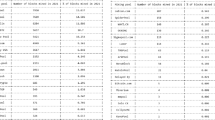Abstract
Recently, Bitcoin is becoming one of the most popular decentralized cryptographic currency technologies, and Bitcoin mining is a process of adding transaction records to Bitcoin’s public ledger of past transactions or blockchain. To obtain a bitcoin, the mining process involves compiling recent transactions into blocks and trying to solve a computationally difficult puzzle, e.g., proof of work puzzle. A proof of work allows miners the ability to quantify how much work a given proof contains. Basically, the required time for mining is decided in advance, but problems will occur if the value is large for dispersion. In this paper, we first accept that the required time between consecutive blocks follows the exponential distribution. That is, the variance is stable as long as the expected time is fixed. Then, we focus on the graph clique mining technique proposed by the literature, like Tromp (BITCOIN 2015) and Bag-Ruj-Sakurai (Inscrypt 2015), which is based on a computational difficulty problem of searching cliques of undirected graphs, where a clique is a subset of vertices. In particular, when the clique size is two, graph clique mining can be used to gain Bitcoins. The previous work also claimed that if the clique size is parameterized and increased, even if the expected time is fixed, the variance would not be stable. However, no qualitative or quantitative results were given to support their claim. Motivated by this issue, in this work, we propose a simple search algorithm for graph cliques mining, and perform a small scale evaluation on Bitcoin and Graph cliques’s solo mining to investigate the variance issue.
Access this chapter
Tax calculation will be finalised at checkout
Purchases are for personal use only
Similar content being viewed by others
References
Antonopoulos, A.M.: Mastering Bitcoin: Unlocking Digital Crypto-Currencies, 1st edn. O’Reilly Media Inc., Sebastopol (2014)
Bag, S., Ruj, S., Sakurai, K.: On the application of clique problem for proof-of-work in cryptocurrencies. In: Lin, D., Wang, X.F., Yung, M. (eds.) Inscrypt 2015. LNCS, vol. 9589, pp. 260–279. Springer, Cham (2016). https://doi.org/10.1007/978-3-319-38898-4_16
Bitcoinwiki: Confirmation. https://en.bitcoin.it/wiki/Confirmation. Accessed 15 Dec 2016
Erdős, P., Renyi, A.: On the evolution of random graphs. In: Publication of the Mathematical Institute of the Hungarian Academy of Sciences, pp. 17–61 (1960)
Feller, W.: An Introduction to Probability Theory and Its Applications, vol. 1. Wiley, York (1968)
Garey, M.R., Johnson, D.S.: Computers and Intractability: A Guide to the Theory of NP-Completeness. W. H. Freeman & Co., New York (1979)
Grimmett, G.R., McDiarmid, C.J.H.: On colouring random graphs. Math. Proc. Cambridge Philos. Soc. 77, 313–324 (1976)
Kraft, D.: Difficulty control for blockchain-based consensus systems. Peer Peer Netw. Appl. 9(2), 397–413 (2016). https://doi.org/10.1007/s12083-015-0347-x
Matsushima, T., Anada, H., Kawamoto, J., Bag, S., Sakurai, K.: Evaluation of bitcoin-mining for search problem of graph cliques. In: Hinokuni Symposium on Information 2016, Miyazaki, Japan, 2–3 March 2016, p. 4B–2 (2016)
Matula, D.: On the complete subgraph of random graph. In: Combinatory Mathematics and Its Applications, pp. 356–369 (1970)
Nakamoto, S.: Bitcoin: A Peer-to-Peer Electronic Cash System (2008). http://bitcoin.org/bitcoin.pdf
Rosenfeld, M.: Analysis of bitcoin pooled mining reward systems. CoRR abs/1112.4980 (2011). http://arxiv.org/abs/1112.4980
Saito, R.: Deriving exponential distribution from geometric distribution. http://chianti.ucsd.edu/~rsaito/ENTRY1/WEB_RS3/PDF/JPN/Texts/half_life1_1.pdf. Accessed 15 Dec 2016
Swan, M.: Blockchain: Blueprint for a New Economy, 1st edn. O’Reilly Media Inc., Sebastopol (2015)
Tromp, J.: Cuckoo cycle: a memory bound graph-theoretic proof-of-work. In: Brenner, M., Christin, N., Johnson, B., Rohloff, K. (eds.) FC 2015. LNCS, vol. 8976, pp. 49–62. Springer, Heidelberg (2015). https://doi.org/10.1007/978-3-662-48051-9_4
WIKIPEDIA: Memorylessness. https://en.wikipedia.org/wiki/Memorylessness. Accessed 15 Dec 2016
Acknowledgement
In the first stage of this research, Hiroaki Anada, Junpei Kawamoto and Kouichi Sakurai were supported by JSPS Kiban(B) JP15H02711. Hiroaki Anada, Chunhua Su and Kouichi Sakurai are supported by JSPS Kiban(B) JP18H03240. Chunhua Su is also supported by JSPS Kiban(C) JP18K11298. Samiran Bag is supported by the ERC starting grant, no. 306994. The authors would like to thank all anonymous reviewers for their insightful comments and suggestions.
Author information
Authors and Affiliations
Corresponding author
Editor information
Editors and Affiliations
Rights and permissions
Copyright information
© 2019 Springer Nature Switzerland AG
About this paper
Cite this paper
Anada, H. et al. (2019). Analysis of Variance of Graph-Clique Mining for Scalable Proof of Work. In: Guo, F., Huang, X., Yung, M. (eds) Information Security and Cryptology. Inscrypt 2018. Lecture Notes in Computer Science(), vol 11449. Springer, Cham. https://doi.org/10.1007/978-3-030-14234-6_6
Download citation
DOI: https://doi.org/10.1007/978-3-030-14234-6_6
Published:
Publisher Name: Springer, Cham
Print ISBN: 978-3-030-14233-9
Online ISBN: 978-3-030-14234-6
eBook Packages: Computer ScienceComputer Science (R0)




